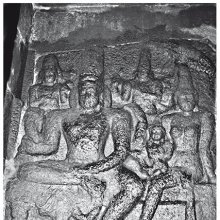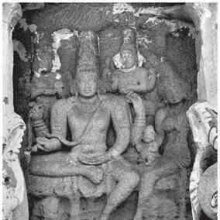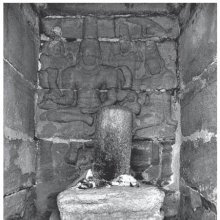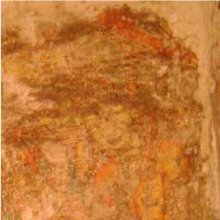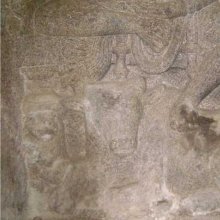Somaskandamurti, Somāskandamūrti, Somaskanda-murti: 3 definitions
Introduction:
Somaskandamurti means something in Hinduism, Sanskrit. If you want to know the exact meaning, history, etymology or English translation of this term then check out the descriptions on this page. Add your comment or reference to a book if you want to contribute to this summary article.
Images (photo gallery)
In Hinduism
Shilpashastra (iconography)
Source: Wisdom Library: Śilpa-śāstraSomāskandamūrti (सोमास्कन्दमूर्ति) refers to an image (mūrti) of Śiva. These type of mūrtis are usually found in most important Śiva temples throughout South-India.
Source: Archaeological Survey of India: Śaiva monuments at Paṭṭadakal (śilpa)Somāskandamūrti (सोमास्कन्दमूर्ति) is found as a sculpture on the third pillar of the maṇḍapa of the temple of Kāśīviśveśvara.—This is an unusual representation of Somāskanda. Both Śiva and Pārvatī are standing. Śiva has four arms of which the lower left is tenderly put on the chignon of Pārvatī. His upper left holds a snake, the upper right the trident and the lower has something which is not identifiable. Pārvati’s right hand encircles the waist of her lord and with the left hand she holds tenderly her child who is sitting happily on the left side of her waist.
By and large, in Somāskanda images Skanda is shown either standing or sitting in between the couple. But here Parvatī is carrying him on her waist like most women in India. The divine couple is surrounded by gaṇa, demi-gods carry rolls of garlands. By the side of Śiva is standing Nandin and the lion of the goddess, gently caressing the bull’s hump and head with his paws. Another persaonnage is standing with folded hands. Others are looking at the divine pair.
Source: Shodhganga: Iconographical representations of Śiva (shilpa)1) Somāskandamūrti (सोमास्कन्दमूर्ति) or simply Somāskanda refers to one of the twenty-eighth forms (mūrti) of Śiva mentioned in the Vātulāgama: twenty-eighth among the Siddhāntaśaivāgama. The forms of Śiva (e.g., Somāskanda-mūrti) are established through a process known as Sādākhya, described as a five-fold process of creation.
2) Somāskandamūrti is also listed among the eight forms (mūrti) of Śiva mentioned in the Rauravāgama: the sixteenth among the Siddhāntaśaivāgamas.
3) Somāskandamūrti is also listed among the eighteen forms (mūrti) of Śiva mentioned in the Śilparatna (twenty-second adhyāya): a technical treatise by Śrīkumāra on Śilpaśāstra.

Shilpashastra (शिल्पशास्त्र, śilpaśāstra) represents the ancient Indian science (shastra) of creative arts (shilpa) such as sculpture, iconography and painting. Closely related to Vastushastra (architecture), they often share the same literature.
See also (Relevant definitions)
Partial matches: Somaskanda, Murti.
Query error!
Full-text: Skandomasahita, Mahesha, Somaskanda.
Relevant text
Search found 4 books and stories containing Somaskandamurti, Somāskandamūrti, Somaskanda-murti, Somāskanda-mūrti; (plurals include: Somaskandamurtis, Somāskandamūrtis, murtis, mūrtis). You can also click to the full overview containing English textual excerpts. Below are direct links for the most relevant articles:
Kashyapa Shilpa-shastra (study) (by K. Vidyuta)
7. Favourable Directions for Installing the Śiva Mūrtis < [Chapter 3 - Prākāra Lakṣaṇa]
Pallava period (Social and Cultural History) (by S. Krishnamurthy)
Shaivism during the Pallava period < [Chapter 3 - Socio-Religious Life]
Dressing style of Upper-class men < [Chapter 4 - Material Culture of the People]
Articles Related to Royal Court < [Chapter 4 - Material Culture of the People]
The Religion and Philosophy of Tevaram (Thevaram) (by M. A. Dorai Rangaswamy)
Chapter 1.3 - Umabhaga-murti (depiction of the Mother Goddess) < [Volume 2 - Nampi Arurar and Mythology]
Temples of Munnur (Historical Study) (by R. Muthuraman)
Images of Subramanya < [Chapter 5]
Related products
